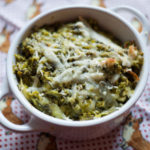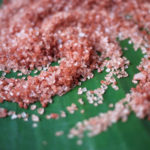So, yesterday I decided to research “Sai Min” (saimin/saimen/saimian), one of my favorite dishes that combines the best things in the world in one bowl of happiness and yumminess. I’ve had it at the hands of my island-famous great-grandfather (who used to own a store/restaurant in Hawai’i, and would cut the noodles by hand).
I thought it was a Cantonese dish, but after much research, I have found that it is unique to the islands! No wonder everyone I talked to about it had no clue what I was saying. Now of course, my family’s Sai Min (famous, let me remind you) is the Chinese version, with no spam, sausages, eggs, or fish cakes like the Filipino/Japanese/Portuguese versions. This has led me to realize that I’m not ethnically or culturally Chinese at all – my family is Hawai’ian, and any Chinese parts of us came as a result of being Hawai’ian, and got mixed up with the Japanese and Filipino aspects that also worked their ways in there. In fact—even our Chinese New Years dinners have Guava Chiffon Pie and Lau Lau sometimes.

Recipe and pictures under the cut.
Saimin(細麵) is a compound of two Chinese words– 細(pinyin: xì, Cantonese: sai), meaning thin, and 麵(miàn, mein), meaning noodle. Saimin is recognized as a traditional state dish in Hawaii, taking into consideration the various historic and cultural significances of its creation. The dish is composed of elements taken from each of the original sugarcane and pineapple plantation laborer ethnicities of the early 20th century: Chinese, Filipino, Japanese, Korean, Hawaiian, Portuguese
As plantation laborers got home to their families in rented plantation lots or shacks, each family would begin cooking dinner. Sometimes, such meals became communal as a means of saving money. Every family would offer an ingredient they were able to spare. The Filipino family might have some extra green onions growing in their yard, the Portuguese family might have leftover sausage, the Hawaiian family’s chickens might have laid a couple extra eggs, the Korean family might have bok choy unused from making kimchi. They would all throw their ingredients into the pot and share. It was through these communal meals that the Hawaiian Pidgin language was developed so they could all understand one another, borrowing words and phrases from each others’ language and piecing them together. In some ways, saimin gave birth to Hawaii’s becoming well known as a haven of multicultural harmony today
This proves that not only is Sai min of Cantonese origin, and was a popular dish among Chinese, but the overall importance of sai min! In fact, they serve sai min in McDonalds in Hawai’i (though I didn’t look for it while I was down there).
Just for fun, here’s my family’s recipe (or the most accurate rendering since I only actually watched my Great-Grandpa make it once.)
Pai’a Sai Min [Lazy Style]
– S&S noodles (if you’re not handmaking the noodles)
– Char Siu (Chinese smoked pork)
– Shoyu (as my great-grandfather calls it) [soy sauce]
– Green onions (though I think bok choy would be a great alternative)
– Pepper
– Chicken broth (canned)
Cook noodles (al dente) in pot of boiling water. Heat up and then slice char siu (its available in butcher shops/grocers on Maui). Heat chicken broth on stovetop. Chop green onions into slices (you can use the whole green onion / scallion, even the white part). Drain noodles and place one scoop (‘spider’ scoop, metal mesh) or 1.5 scoop in a bowl and pour broth on top. Add shoyu to taste (some like it dark, some like it light) and sprinkle in green onions. Stir the noodles and soup a little and grind some pepper on top. Stir again. Add a few slices of char siu on top of the soup and enjoy with chopsticks and your soup spoon!

















that looks like such a great comfort meal! do you think an egg would be good in it? i think so 🙂
Olga, this would taste great with a soft-boiled egg in it! A poached egg might be a bit much, but if you leave the gravy out of the broth (my dad always sneaks gravy in), it could add a good richness!